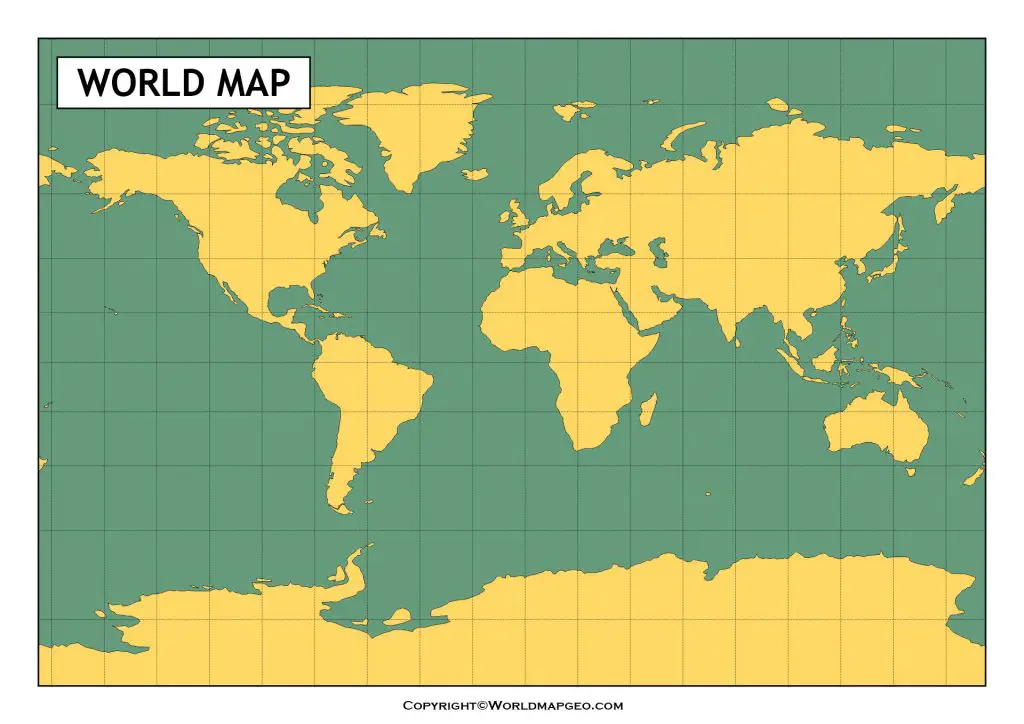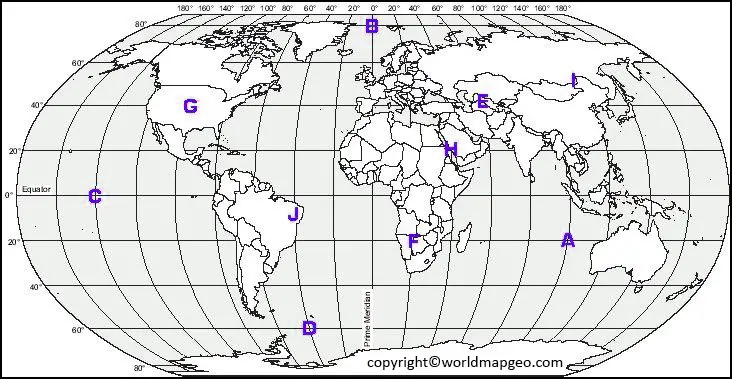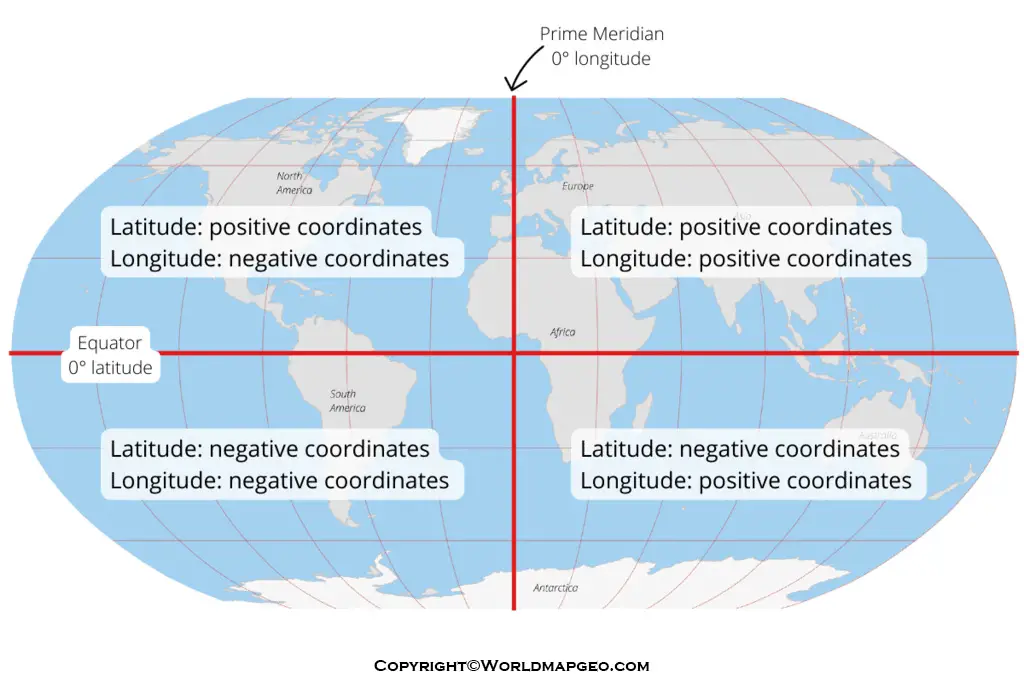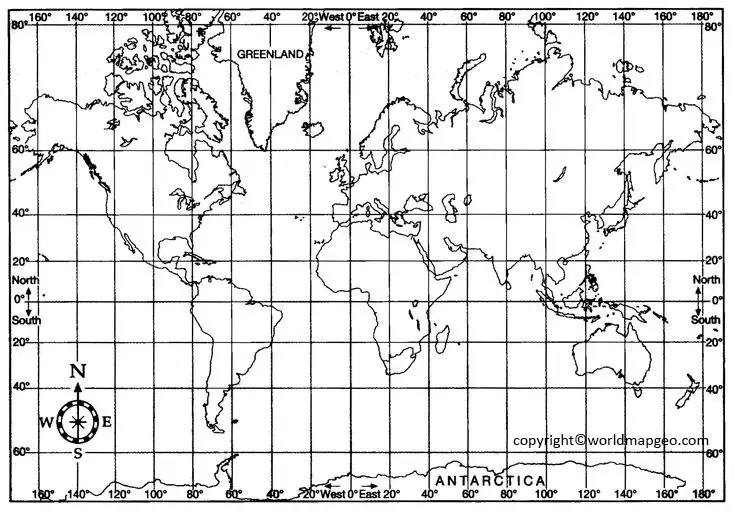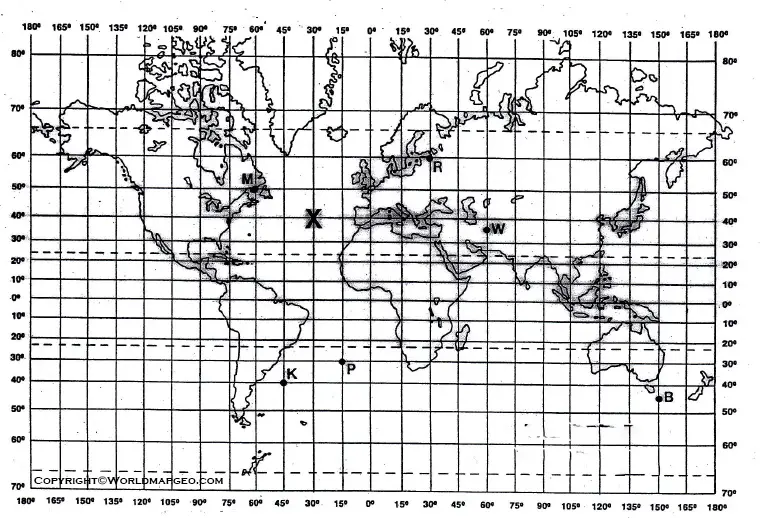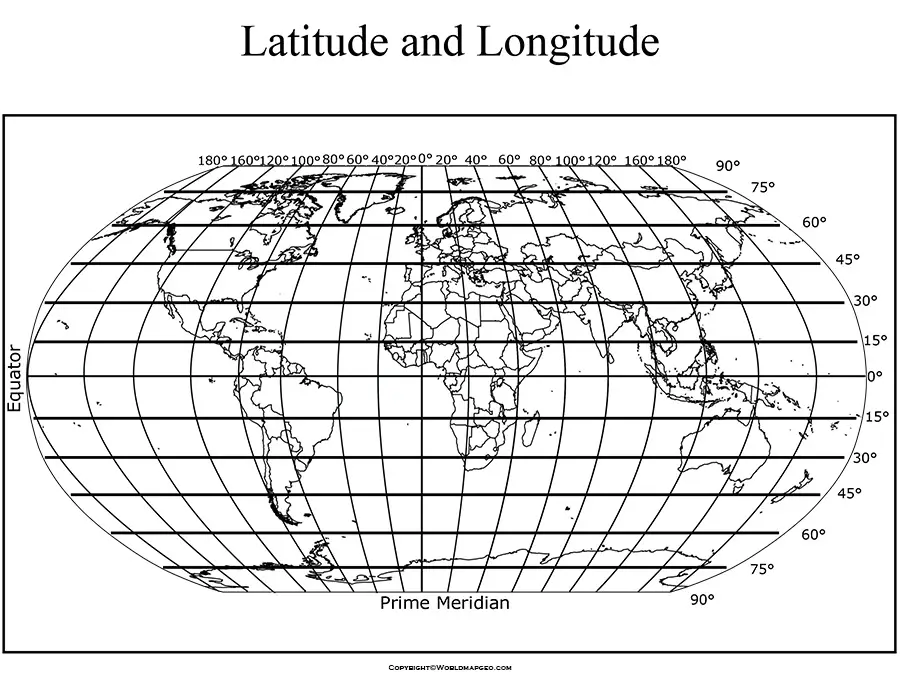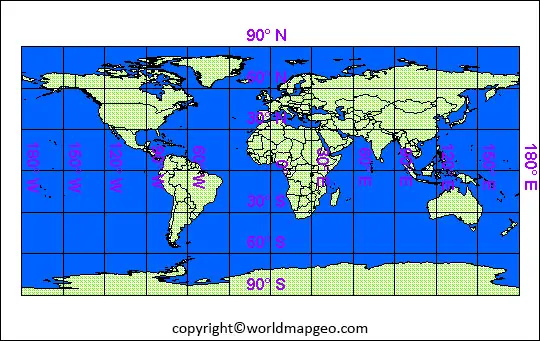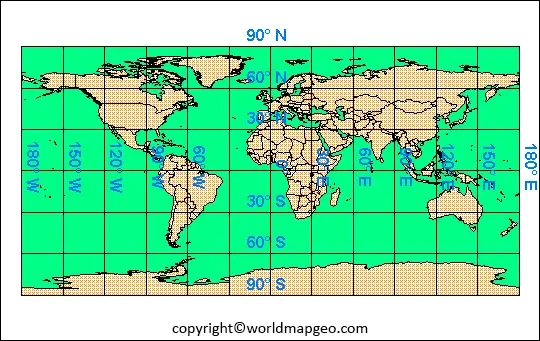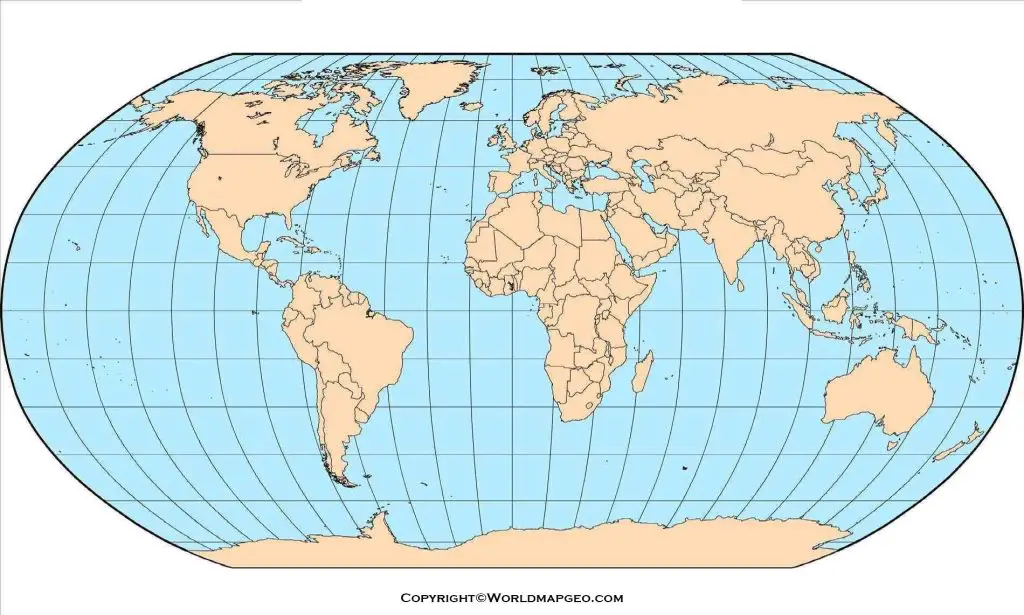A Latitude and Longitude Map is available online for professional and personal reasons. Maps used to find all of the world’s important and notable sites and all of the things that these areas known for. Every country in the world has its global map and specific world maps for particular regions and landmarks. Rivers, airports, and other monuments and tourist attractions all marked on the blank globe maps.
However, it is also critical that you comprehend the significance of the global map that includes latitudes. Latitudes defined as two coordinates used to plot specific locations on the globe. Latitudes can used to locate any particular spot in the world. The exact location can also determined using the world map’s latitudes.
Latitude and Longitude Map
A latitude and longitude map is a powerful tool used to locate any point on Earth’s surface with great precision. Latitude and longitude geographical coordinates that provide a reference system for identifying specific locations. Latitude lines run horizontally and measure the distance north or south of the equator, while longitude lines run vertically and measure the distance east or west of the Prime Meridian.
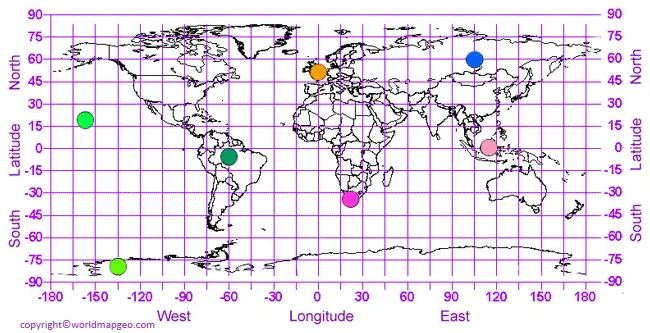
These maps invaluable in navigation, cartography, and various scientific disciplines. By using latitude and longitude coordinates, travelers can plan their journeys, and explorers can record their discoveries accurately. Additionally, meteorologists use these maps to track weather patterns, and geographers analyze spatial relationships between different regions.
The lines of latitude and longitude intersect to form a grid system that divides the Earth’s surface into smaller sections, enabling accurate positioning. Cartographers typically represent these coordinates using degrees, minutes, and seconds or in decimal format. Thanks to advancements in digital mapping technology, individuals can now access interactive latitude and longitude maps online, making it easier than ever to explore and understand our planet’s vast geography.
Interactive World Map With Latitude and Longitude
An interactive world map with latitude and longitude is a powerful tool that enables users to explore the globe with precision. Through modern web technologies, such maps have become increasingly popular as they offer dynamic and user-friendly experiences. These interactive maps typically display the Earth’s surface, allowing users to zoom in and out, pan, and click on specific locations to obtain detailed information. Latitude and longitude lines prominently featured on the map, providing precise coordinates for any point on Earth.
One of the key benefits of an interactive world map with latitude and longitude is its versatility in various fields. In education, it serves as an engaging tool for teaching geography and understanding global locations. For travelers and adventurers, it aids in planning routes and exploring unfamiliar regions. Businesses can also utilize these maps to visualize data, such as customer locations or sales distribution, on a global scale. Furthermore, with the integration of real-time data and overlays, users can access live weather updates, population statistics, and much more.
Developing such an interactive map requires a combination of programming languages, like JavaScript and HTML5, and libraries like Leaflet or Google Maps API. These technologies empower developers to add interactivity and dynamic features to the map. Additionally, the map can enhanced with various layers, such as topography, political boundaries, or satellite imagery, to cater to diverse user needs.
Full-Size World Map with Latitude and Longitude Lines
A full-size world map with latitude and longitude lines is a comprehensive cartographic representation of the Earth’s surface, detailing the intricate network of latitude and longitude coordinates. This type of map is often displayed on a large scale to ensure clarity and accuracy, allowing users to study geographic features, measure distances, and locate points precisely.
Latitude and longitude lines the grid system used to pinpoint any location on Earth. Latitude lines run horizontally, measuring the distance north and south of the Equator, while longitude lines run vertically, measuring the distance east and west of the Prime Meridian. Together, these lines create a precise and universally accepted method for navigation and geographic referencing.
Geographers, navigators, and students find full-size world maps with latitude and longitude lines particularly useful. In educational settings, they aid in teaching geography and understanding Earth’s global structure. They serve as essential tools for marine and air navigation, helping pilots and sailors chart their courses accurately. Additionally, such maps used in diverse scientific disciplines, from climate research to astronomy, to pinpoint specific observation locations.
Cartographers employ various projection methods to depict the curved Earth’s surface on a flat map. The most common projection used in full-size world maps is the Mercator projection, known for its ability to maintain straight lines of constant compass bearing. However, it distorts size and shape, particularly near the poles. Other projections, like the Robinson and Winkel Tripel, aim to balance distortion across the entire map.
World Map with Latitude and Longitude
A world map with latitude and longitude is a fundamental cartographic representation that highlights the Earth’s global coordinates. It visually presents the lines of latitude and longitude, helping users identify specific locations and understand the spatial relationships between different regions.
Latitude and longitude imaginary lines that form a grid on the Earth’s surface. Latitude lines run parallel to the Equator and measure the distance north or south of it. In contrast, longitude lines run from pole to pole and measure the distance east or west of the Prime Meridian, which is the reference line passing through Greenwich, England.
The world map with latitude and longitude serves multiple purposes across various fields. Geographers and cartographers use it to illustrate geographic features, such as continents, countries, and oceans, and to depict the distribution of climate zones and ecosystems. It aids in navigation, allowing travelers and explorers to plan routes and understand their positions accurately. Additionally, scientists employ such maps in research to study spatial patterns and phenomena across the globe.
Various map projections used to display the curved Earth on a two-dimensional surface. Each projection has its advantages and drawbacks, and cartographers select the most suitable one based on the map’s purpose and the area it emphasizes. Popular projections for world maps include the Mercator, Robinson, and Winkel Tripel projections.
Earth Latitude and Longitude Map
An Earth latitude and longitude map is a cartographic representation that showcases the geographic coordinates of every point on the planet. This map is an indispensable tool for navigation, geography, and various scientific disciplines. It provides a comprehensive view of the Earth’s surface, allowing users to pinpoint any location accurately.
Latitude and longitude essential geographic concepts used to describe locations on the Earth. Latitude lines run east-west and measured in degrees north or south of the Equator. Longitude lines run north-south and measured in degrees east or west of the Prime Meridian. Together, they create a global grid system that aids in precise location identification.
For navigational purposes, the Earth latitude and longitude map is invaluable to pilots, sailors, and hikers. With this map, they can plan routes, estimate distances, and determine their positions with great accuracy. Furthermore, emergency services rely on this map to respond effectively to crises and reach specific locations swiftly.
Geographers and environmental scientists use Earth latitude and longitude maps to study the distribution of landforms, climates, and ecosystems. By understanding the geographic coordinates of different regions, they can analyze spatial patterns and identify factors influencing the Earth’s environmental dynamics.
Modern Earth latitude and longitude maps typically available in various formats, including physical paper maps, digital applications, and online platforms. With the advent of satellite technology, digital maps now incorporate real-time data, offering up-to-date information on weather conditions, traffic, and other relevant data overlays.
Latitude Longitude Map
A latitude longitude map is a cartographic representation that focuses on displaying the Earth’s grid system of latitude and longitude lines. This map type is specifically designed to highlight the geographic coordinates of different locations worldwide, providing a concise and accurate reference tool.
Latitude and longitude the foundation of the map, enabling users to determine exact positions on the Earth’s surface. Latitude lines, also known as parallels, run parallel to the Equator and measure the distance north or south of it in degrees. Longitude lines, also known as meridians, run from pole to pole and measure the distance east or west of the Prime Meridian in degrees.
The latitude longitude map serves a wide range of purposes across various industries and disciplines. For travelers and hikers, it helps with route planning, navigation, and identifying landmarks along their journey. Researchers in geography, environmental science, and urban planning utilize this map to analyze spatial patterns, study climatic zones, and understand the distribution of natural resources.
The map’s cartographic representation is crucial to ensure the accurate depiction of the Earth’s curved surface on a flat sheet. Various projection methods employed to minimize distortion in size, shape, and direction. The choice of projection depends on the area of interest and the specific application of the map.
In the digital age, latitude longitude maps have become widely accessible through various platforms and applications. Online mapping services and geographic information systems (GIS) allow users to interact with the map, overlay data, and perform advanced spatial analysis. These interactive features have revolutionized the way we explore and interpret geographic information.
Latitude and Longitude Map of World
A latitude and longitude map of the world is a comprehensive cartographic representation that showcases the global coordinates of every point on Earth’s surface. This map offers a detailed view of the Earth’s grid system, enabling users to identify precise locations, measure distances, and understand spatial relationships across the entire planet.
Latitude and longitude are essential geographic concepts used to describe positions on Earth. Latitude lines run parallel to the Equator and are measured in degrees north or south. Longitude lines run from pole to pole and are measured in degrees east. Or west of the Prime Meridian, which passes through Greenwich, England.
The latitude and longitude map of the world serves multiple purposes in various domains. For navigation and exploration, it aids travelers, pilots, and sailors in planning routes, determining positions, and estimating distances accurately. In education, the map serves as a powerful tool for teaching geography and fostering a global perspective among students.
Geographers and researchers rely on the latitude and longitude map to study spatial patterns. Analyze climate zones, and explore the distribution of landforms and ecosystems. Additionally, this map is instrumental in disaster management, enabling emergency services to respond effectively to crises and reach specific locations in times of need.
Creating an accurate latitude and longitude map of the world is a complex task. Due to the challenge of depicting the Earth’s curved surface on a flat map. Cartographers employ various projection techniques. To minimize distortions and preserve important geographic features. The choice of projection depends on the map’s purpose and the area of interest.
